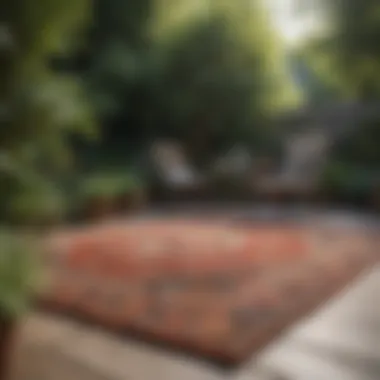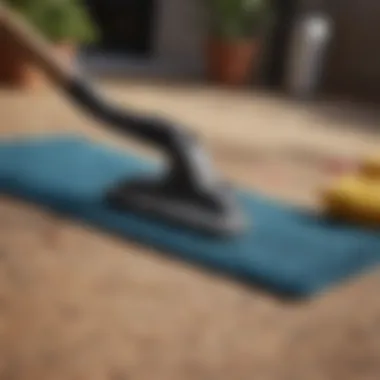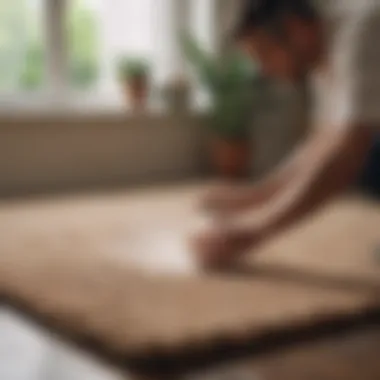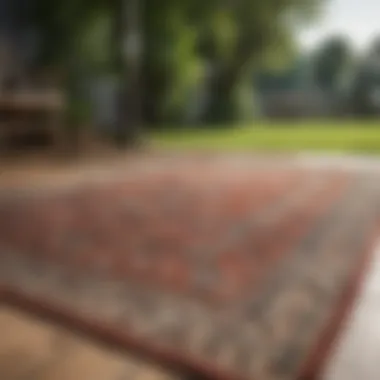Expert Guide to Cleaning Large Outdoor Rugs


Intro
Maintaining the appearance and condition of large outdoor rugs is not merely a cosmetic choice; it’s a necessity for prolonging their life and enhancing outdoor spaces. Homeowners and enthusiasts may find themselves questioning the best methods for care. With various materials used in outdoor rugs, understanding the right cleaning techniques becomes crucial. This guide presents a comprehensive overview aimed at equipping individuals with practical advice for cleaning and maintaining their outdoor rugs.
Importance of Cleaning Outdoor Rugs
Outdoor rugs are often subject to the elements, collecting dirt, moisture, and other debris. A thorough cleaning routine improves the aesthetic appeal of any outdoor area and helps preserve the integrity of the rug's material. Regular maintenance ensures that the fibers remain intact and that colors do not fade, contributing to the longevity of these decorative pieces.
Key Points to Cover
In this article, you will explore the following:
- Methods for effective cleaning of large outdoor rugs.
- Essential equipment and tools for the job.
- Tips for maintenance that preserve both beauty and function.
With the right information in hand, you can transform your outdoor space while protecting and extending the life of your rugs.
Prelude
Cleaning a large outdoor rug is an essential task that many homeowners often overlook. Such rugs not only enhance the aesthetic appeal of outdoor spaces but also provide comfort and functionality. However, they are susceptible to dirt, stains, and wear caused by environmental elements. This guide aims to elucidate the various methods and techniques for cleaning these rugs to maintain their condition and appearance.
The importance of cleaning outdoor rugs goes beyond mere aesthetics. Regular cleaning helps to prolong the lifespan of the rug, preserving its material integrity against the elements. For instance, outdoor rugs tend to gather dust, pollen, and moisture, which can wear down fibers over time. Thus, understanding effective cleaning methods is crucial.
In this article, we will delve into the types and materials of outdoor rugs, as well as common uses. We will also explore pre-cleaning preparations, various cleaning techniques, post-cleaning care, and common mistakes to avoid. By providing a comprehensive approach to rug maintenance, this guide will serve as an invaluable resource for homeowners, interior design enthusiasts, party hosts, and gardening devotees alike. Each section will offer practical advice, ensuring that readers can tackle rug cleaning tasks with confidence and competence.
This thorough examination of outdoor rug cleaning will allow for a better understanding of how to keep these functional and aesthetic pieces in optimal condition.
Understanding Outdoor Rugs
Having a clear understanding of outdoor rugs is essential for proper care and maintenance. These rugs are not just decorative pieces; they are functional items that enhance outdoor spaces. Knowing the types, materials, and common uses of outdoor rugs helps ensure you select the right one that meets your needs and expectations.
Types of Outdoor Rugs
There are several types of outdoor rugs available, each designed for specific purposes. Here are some common categories:
- Water-resistant rugs: These rugs are treated to repel water. They dry quickly, making them ideal for areas prone to spills or rain.
- UV-resistant rugs: They are made with materials that withstand fading in sunlight. This is beneficial for patios or decks exposed to direct sunlight for long periods.
- Heavy-duty outdoor rugs: Designed specifically for high traffic areas, these rugs can endure more wear and tear compared to other types.
- Eco-friendly rugs: Made from natural fibers or recycled materials, these rugs appeal to environmentally conscious consumers.
Choosing the right type varies based on your specific outdoor needs. Consider the placement area, climate conditions, and intended use to find the most fitting option.
Materials Used in Outdoor Rugs
The materials used for outdoor rugs play a significant role in their durability and performance. Some of the common materials include:
- Polypropylene: This synthetic fiber is durable, resistant to stains, and easy to clean. It is often used in outdoor rugs due to its water-resistant properties.
- Nylon: Another synthetic option, nylon is known for its resilience. It can withstand heavy foot traffic and is often found in commercial settings but may not be as UV resistant as polypropylene.
- Natural fibers: Materials like jute or sisal are eco-friendly. However, they are less resistant to water, making them suitable for covered outdoor spaces.
- Acrylic: This material is soft and comfortable. It is typically resistant to fading and can handle various weather conditions, sk ideal for a comfortable outdoor feel.
Understanding these materials helps in selecting a rug that fits your lifestyle while enhancing the outdoor aesthetic.
Common Uses of Outdoor Rugs
Outdoor rugs serve a variety of purposes. Below are some common uses that highlight their versatility:


- Enhancing outdoor aesthetics: Outdoor rugs can add color and texture to patios, decks, or porches. They create a warm and inviting environment.
- Defining spaces: They help in dividing different areas, like dining spaces from lounging areas, allowing for better flow in outdoor settings.
- Protecting surfaces: Using rugs can reduce wear on outdoor surfaces. They protect decks or patios from scratches and fading caused by furniture.
- Providing comfort: Outdoor rugs add comfort underfoot, especially over hard surfaces like concrete or stone.
Recognizing these uses provides insight into incorporating outdoor rugs into your spaces effectively. Whether for style or function, understanding their applications will guide homeowners in making informed decisions.
Pre-cleaning Preparations
Preparing for the cleaning of a large outdoor rug may seem like a tedious task, but it actually lays a solid foundation for successful results. The right preparations help to ensure that the rug receives the best care possible. This involves assessing the rug’s condition, gathering the necessary supplies, and selecting an appropriate cleaning location.
Assessing the Rug's Condition
Before diving into the actual cleaning process, it is crucial to assess the condition of the rug. This means checking for any visible damage, fraying edges, or fading. Identify any areas that may need special attention, such as heavy stains or wear spots. Understanding the rug's current state will help determine the best cleaning approach and techniques to use. By being thorough in this step, you can avoid damaging the rug during cleaning.
Gathering Necessary Supplies
Having the right cleaning supplies is essential. Here are some key items you should gather:
Vacuum cleaner
A vacuum cleaner is fundamental for cleaning an outdoor rug. It effectively removes dirt and debris that can accumulate over time. Ensure you choose a vacuum cleaner that has strong suction power but is gentle enough not to damage the fibers of the rug. A vacuum with adjustable height settings is ideal, as it allows you to adapt to different rug pile heights. Avoid using vacuums with beater bars, as they may cause wear and tear.
Gentle detergent
Selecting a gentle detergent is vital for maintaining the integrity of the rug. Gentle detergents are formulated to clean without harsh chemicals that could damage the fibers. When looking for a detergent, ensure it is specifically designed for cleaning rugs or carpets. A biodegradable detergent is favorable due to its environmentally friendly nature. Its unique feature is the pH balance that allows effective cleaning without harming the material.
Brushes
Brushes are useful for scrubbing away dirt and stains. It is recommended to use a soft-bristled brush, as this will be effective without being too abrasive. Brushes with sturdy handles are beneficial for applying the right amount of pressure uniformly. You want to be careful not to use stiff brushes, as they can scratch or fray surfaces. A quality brush can make the cleaning process much smoother.
Water source
A reliable water source is essential for rinsing out detergents and cleaning solutions. Whether it’s a garden hose or a nearby faucet, you need access to clean water. A hose is beneficial because it allows you to rinse large areas quickly. Ensure that the water pressure is adequate; too high might damage the rug fibers, while too low might not remove stubborn dirt sufficiently.
Protective gear
Don’t overlook the importance of protective gear. Wearing rubber gloves can protect your hands from detergents and any allergens. It’s also wise to wear a mask if you are sensitive to dust. Sturdy footwear is recommended as you may be working outside where conditions can be uneven. Safety should always be a priority when engaging in cleaning activities, especially for large outdoor items.
Choosing an Appropriate Cleaning Location
Selecting a suitable location for cleaning your rug is paramount. Ideally, this should be a spacious outdoor area where dirt and water can be managed easily. A flat, hard surface like a patio or driveway is perfect. Avoid areas with direct sunlight during the heat of the day, as this could lead to premature drying and potentially cause water spots or detergent residue to remain on the rug. Having a covered area or shade will help facilitate optimal cleaning conditions. Make sure to clean in a well-ventilated space, this will also speed up drying time.
In summary, pre-cleaning preparations are not just formalities; they are essential steps that ensure the cleaning process itself is productive and effective. Each step helps protect the integrity and longevity of your outdoor rug.
Cleaning Techniques
Cleaning techniques for outdoor rugs are vital for maintaining their appearance and durability. These methods help remove dirt, stains, and mildew, significantly prolonging the lifespan of the rug. They also enhance the aesthetic appeal of open-air spaces, making them more inviting. Understanding various cleaning techniques allows homeowners and enthusiasts to choose the most suitable approach based on the rug's material and condition.
Vacuuming the Rug
Vacuuming is often the first step in cleaning an outdoor rug. It removes loose dirt, dust, and debris that accumulate over time. For larger rugs, using a vacuum equipped with a wide attachment is ideal. This allows for faster cleaning without damaging the fibers. It's important not to skip this step as it lays the foundation for more thorough cleaning methods. Regular vacuuming keeps the rug looking fresh and can diminish the growth of mildew and mold.


Spot Cleaning Stains
Spot cleaning is essential for addressing stains before they set in or spread. Here are key aspects involved in this process:
Identifying the type of stain
Understanding the type of stain is crucial in choosing the right cleaning method. Different stains, such as food, grease, or ink, require specific treatments. For instance, oil stains respond well to absorbent powders, while organic stains benefit from gentle detergent solutions. Knowing the stain's nature ensures targeted treatment, providing better results and reducing the risk of damage to the rug.
Applying the right cleaning solution
Using the correct cleaning solution is equally important. The right product will effectively lift the stain while protecting the rug's material. For example, a gentle detergent works well for most stains without degrading the fabric. Always test the solution on a small, inconspicuous area first to ensure it does not cause discoloration. The choice of cleaner can influence the overall cleaning outcome significantly.
Gentle scrubbing techniques
When stains remain, gentle scrubbing can be very effective. Using a soft-bristle brush can help lift the stain without harming the rug fibers. It's advisable to scrub in a circular motion to loosen the dirt effectively. However, one must be cautious not to apply too much pressure, as this may damage the rug. Employing gentle techniques can aid in stain removal while preserving the rug's integrity.
Deep Cleaning the Entire Rug
Deep cleaning is recommended periodically to keep outdoor rugs in top condition. This method goes beyond surface cleaning and addresses deeper dirt and allergens.
Using a power washer
A power washer can save time and effort. It effectively blasts away dirt and grime, making it ideal for large rugs. However, care must be taken to use the correct pressure setting; too high a pressure can ruin the rug. It is advisable to use a fan nozzle to ensure an even application of water and cleaning solutions.
Submerging in water
For extremely dirty rugs, submerging them in a large tub or pool of water can be effective. This method allows for thorough cleaning, especially for rugs resistant to direct pressure. When submerging, use warm water combined with a gentle detergent to maximize cleaning power. However, this method may not be suitable for all materials, so always check the manufacturer's guidelines first.
Scrubbing methods
After soaking, scrubbing can enhance the cleaning process. A combination of gentle brushing and a suitable cleaning solution can significantly improve the rug's overall cleanliness. Different scrubbing tools are available, from brushes to cloths. Choosing the right tool depends on the rug material. Care should also be taken not to damage the fibers while scrubbing. Overall, proper scrubbing techniques can yield a clean and refreshed outdoor rug.
Post-cleaning Care
Post-cleaning care is essential for preserving the integrity and appearance of a large outdoor rug. Once the rug is cleaned, immediate and proper attention ensures that it remains in good condition for an extended period. Effective post-cleaning techniques can prevent common issues such as mold, mildew, and fading. Additionally, taking steps to maintain the rug can enhance its overall lifespan significantly.
Drying the Rug
Air drying techniques
Air drying is the most recommended technique for drying an outdoor rug. This method utilizes natural breezes and sunlight, which helps remove moisture effectively without causing damage to the fibers. One of the key characteristics of air drying is its gentleness; it avoids the aggressive heat of traditional dryers. This choice is advantageous as high heat can lead to shrinkage or warping of the materials used in outdoor rugs.
A unique feature of air drying is that it is eco-friendly and does not consume any energy. However, it may take longer for thicker rugs to dry completely compared to mechanical drying methods.
Avoiding direct sunlight
While drying outdoor rugs, avoiding direct sunlight is critical. Prolonged exposure can fade colors or weaken the fibers over time. The key characteristic of this method is the preservation of the dye and material quality. This is crucial, especially for rugs with vibrant tones that can be affected by UV exposure.
The unique benefit of avoiding direct sunlight is that it helps maintain color consistency. However, one downside is that drying may take longer in shaded areas. Thus, a balance between adequate airflow and protection from direct sun is necessary.
Maintaining the Rug's Health
Regular cleaning schedule


Establishing a regular cleaning schedule contributes significantly to the overall health of an outdoor rug. This ensures that dirt and debris do not build up, which can create stains and damage fibers over time. The key characteristic of a cleaning schedule is consistency; it keeps the rug looking fresh without needing extensive cleanings every few months. This practice is beneficial because it simplifies the cleaning process, allowing it to become more manageable rather than overwhelming.
A unique feature of a regular cleaning routine is that it can be tailored according to weather conditions and usage frequency. The only disadvantage might be the time commitment, but even short, frequent cleanings can yield excellent long-term results.
Protective treatments
Applying protective treatments to outdoor rugs is another wise step in maintenance. These treatments can provide a barrier against stains and UV damage. The key aspect of protective treatments is their ability to enhance the durability of the rug. This choice is particularly popular among homeowners who want to extend their rug's life without frequent cleaning.
A unique feature of these treatments is that they often come in spray form, making application quick and straightforward. However, regular reapplication may be necessary, depending on exposure to elements. Homeowners should consider this aspect when deciding on the frequency of treatment.
Storing the Rug Properly
Rolling vs. folding
When it becomes necessary to store an outdoor rug, the choice between rolling and folding may arise. Rolling is often the preferred method as it minimizes creases and maintains the structural integrity of the rug. This practice is beneficial because it helps preserve the rug’s shape and comfort.
Folding, while easier for space-saving, can create permanent creases that may be difficult to eliminate later. Thus, rolling is generally the favored option, even though it may take more space in storage.
Choosing a storage location
Selecting the right storage location is crucial for the rug's well-being when it's not in use. A dry, cool place protects the rug from moisture and pests, factors that can lead to mold or mildew. The key characteristic of a proper storage area is ventilation; it diminishes the risk of dampness. This option is beneficial because it safeguards the rug while it is stored, ensuring it remains usable for longer.
One unique advantage of storing the rug in a well-ventilated area is the decreased risk of odors developing. On the downside, many people may overlook this aspect, leading to improper conditions that can harm the rug eventually.
Common Mistakes to Avoid
Cleaning a large outdoor rug might seem straightforward, but there are several pitfalls that can hinder the process and diminish the rug's longevity. It is essential to recognize these common mistakes to ensure that proper care is taken, thereby preserving both the rug's appearance and functionality. This section outlines key missteps, providing clarity on how to avoid them for optimal results.
Using Harsh Chemicals
Many people believe that stronger cleaning agents yield better results. However, the opposite can often be true when it comes to outdoor rugs. Harsh chemicals can cause fading, discoloration, and even damage to the fibers of the rug. High concentrations of bleach or aggressive solvents can break down the material over time.
Using gentle, environmentally friendly detergents is a wise choice. Products specifically formulated for outdoor textiles generally feature milder ingredients, ensuring effective cleaning while maintaining the integrity of the rug. Always check that the selected cleaner is safe for the fabric type. Before applying any substance, it’s prudent to test a small area to assess compatibility. This approach minimizes risks associated with chemical reactions that can lead to unintended damage.
Neglecting Regular Maintenance
Regular maintenance is crucial for the durability of outdoor rugs. Many homeowners underestimate the importance of consistent upkeep. Failing to vacuum or shake out debris leads to a buildup of dirt and grime, which can trap moisture and encourage mold growth. Moreover, neglecting seasonal cleanings can result in stains becoming entrenched, making future cleaning efforts more challenging and less effective.
To maintain your rug, establish a cleaning routine that includes vacuuming at least once a month. For high-traffic areas, more frequent attention may be necessary. A well-maintained rug not only looks better but also lasts longer, saving homeowners replacement costs in the long run.
Improper Drying Techniques
After cleaning, drying your outdoor rug may seem simple, yet improper techniques can cause significant issues. One common mistake is drying a rug too quickly or in direct sunlight, which can lead to fading and materials becoming brittle. On the other hand, not drying a rug thoroughly can result in mold and mildew growth, negating the effects of cleaning.
For optimal drying, air drying in a shaded space is recommended. Adequate airflow is critical; turning the rug occasionally can help facilitate uniform drying. Moreover, ensure that the rug is completely dry before placing it back in its designated area. Investing the time to dry correctly is essential for maintaining the rug’s appearance and extending its lifespan.
"Proper care and awareness can transform your outdoor rug from a potential eyesore into a valued outdoor accessory."
By recognizing and avoiding these common mistakes, homeowners can significantly enhance the effectiveness of their cleaning efforts, contributing to a long-lasting relationship with their outdoor rugs.
Epilogue
Cleaning a large outdoor rug is not merely an exercise in aesthetics; it significantly influences the longevity and functionality of the rug. As we've explored throughout this guide, understanding the materials and types of rugs informs the cleaning process, ensuring that the cleaning methods used do not compromise the integrity of the rug. An outdoor rug, subject to varying weather conditions and frequent foot traffic, requires a tailored approach for maintenance and cleaning.
By adopting a systematic method for both cleaning and post-cleaning care, homeowners can enhance the rug’s appearance and ensure it remains in optimal condition. Neglecting these elements can lead to irreversible damage or a decline in the rug’s visual appeal, which may necessitate costly replacements.
Key Considerations:
- Material Awareness: Different materials require specific cleaning methods. Understanding synthetic versus natural fibers can prevent damage.
- Regular Maintenance: A structured cleaning schedule helps to prevent stains and wear. Regular upkeep is often more effective than deep cleaning only when problems arise.
- Appropriate Techniques: Using the right techniques—be it vacuuming, spot cleaning, or deep washing—is essential to preserve the rug.
- Post-cleaning Practices: Caring for the rug after it has been cleaned is crucial. Techniques like air drying and avoiding excess sunlight extend the life of the materials.
Homeowners, along with gardening enthusiasts and interior design aficionados, should prioritize these cleaning techniques to maintain both functionality and aesthetics. A well-cared-for outdoor rug not only enhances the outdoor space but also reflects a commitment to home care and design sensibility.
"A clean outdoor rug contributes to the overall beauty and harmony of outdoor living spaces."
Embracing these practices will ultimately lead to a rewarding investment, not only in the physical rug itself but in the broader ambiance of outdoor areas.



